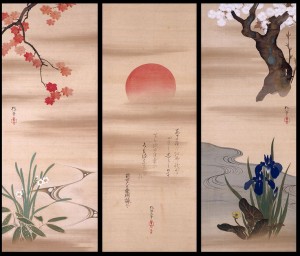Every flower is a soul blossoming in nature. ~Gerard De Nerval
Art is subjective and the concept of what determines beauty within a generation of people changes over time; when the majority takes a leap forward toward a grander scheme of knowledge the perspectives of beauty changes. During the Edo era (1615-1868), Japanese art often relied on tropes from nature, especially flowers.
A large portion of the cultural identity of the Japanese is influenced by Buddhism, leading them to invest in the concept of impermanence, or constant change. As a result, nature plays a significant role in their art. Ironically, Sakai Hōitsu became ordained as a Buddhist monk in 1797, explaining his choice for painting seasons. The seasons symbolize the impermanence of the Buddhist religion. Japanese Buddhist traditions, requires one being aware that you must live in the moment and be grateful for life. Nature is important within Buddhism, because understanding nature is a necessity for the comprehension of one’s inner self leading to enlightenment. The seasons of Japan are consistently in a cycle of change. Sakai Hōitsu’s The Rising Sun with Flowers and Trees of the Four Seasons brings the significance of these Buddhists beliefs into perspective. The image reflects the impact of Buddhism on Japanese culture with its focus on the four seasons in nature–the cycle of constant change that mirrors the impermanence of the human condition.
Sakai Hōitsu, Japanese artist, born in 1761 in the city of Edo, which is now present day Tokyo, was born into one of the highest-ranking daimyo clans (a family of wealth) within the district of Kanda. This gave him access to the world of art and a lavish lifestyle that allowed him to be able to observe the exquisite nature of Japan. Hōitsu focuses his paintings on the observations of nature and the surroundings of Japan. The fluid–like lines of the painting invokes a realistic view of how one may view a flower in Japan. Hōitsu’s choice of incorporating the lively atmosphere of Japan through the means of flowers embody a long term view of the blossoming of flowers from different seasons. The picture ranges from the cherry tree, representative of the spring months, to the irises signifying summer. Also included are the branches of an autumnal maple tree symbolizing fall and the narcissi flowers, which is evocative of winter. Details such as snow, rivers, and unsymmetrical leaves allows for the complete visualization of the nature in the country.
The Japanese calligraphy in the painting sheds light upon the message that the artist is meant to bring out that the painting alone could not explain. In the middle of the Triptych of hanging scrolls underneath the rising sun translate as follows:
Praise for the enlightened
reign of the emperor
spreads in all directions,
just as the light of the sun
shines in a cloudless sky.
Viewers will take immediate recognition of the red rising sun in the middle of this triptych, which was an emblem of Japan before it appeared on the flag. The poem is meant to give reference to the emperors and how they are the light to a new nation. It’s also about manifest sovereignty. They are saying they are sovereign over the world—for the sun shines on all the world, not just japan. Everything the light touches will be the limit of what the emperor would reign including the flowers of the various seasons.
Cultural identity comes through Hōitsu’s work “The Rising Sun with Flowers and Trees of the Four Seasons” through the means of religion, government, and the flowers inhabited to the native area of Japan. These unique historical, political, and geographical contexts are what makes up the true culture of the country and once the viewer realizes the culture behind the painting they will become bi-cultural.
SWL
Works Cited
McKelway, Matthew P. “Flowers and Rising Sun.” Silver Wind The Arts of Sakai Hōitsu (1761-1828). Distr. Yale University Press, New Haven & London. New York: Japan Society, n.d. 112-13. Print.
Parkes, Graham. “Japanese Aesthetics.” Stanford University. Stanford University, 12 Dec. 2005. Web. 15 July 2015. <http://plato.stanford.edu/entries/japanese-aesthetics/>.
“Sakai Hōitsu | The Rising Sun with Flowers and Trees of the Four Seasons | Japan | Edo Period (1615–1868).” The Metropolitan Museum of Art, I.e. The Met Museum, 2 Feb. 2000. Web. 15 July 2015. <http://metmuseum.org/exhibitions/view?exhibitionId=%7B5bc821dc-2782-4897-854f-ebbdc0f09577%7D&oid=77220>.
“Fundamental Structure of the Government of Japan.” Fundamental Structure of the Government of Japan. N.p., 4 Mar. 2007. Web. 15 July 2015. <http://japan.kantei.go.jp/constitution_and_government_of_japan/fundamental_e.html>.
